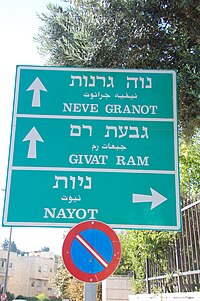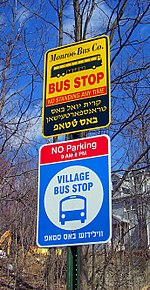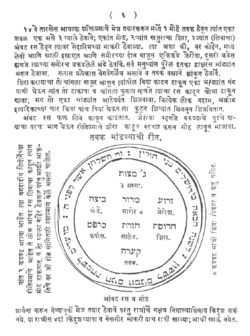What Language Do Jewish People Speak In Service
Jewish languages are the various languages and dialects that developed in Jewish communities in the diaspora. The original Jewish language is Hebrew, supplanted as the main vernacular by Aramaic following the Babylonian exile. Jewish languages feature a syncretism of ethnic Hebrew and Judeo-Aramaic with the languages of the local non-Jewish population.
Aboriginal history [edit]
Early Northwest Semitic (ENWS) materials are attested through the end of the Statuary Age—2350 to 1200 BCE.[i] At this early state, Biblical Hebrew was not highly differentiated from the other Northwest Semitic languages (Ugaritic and Amarna Canaanite), though noticeable differentiation did occur during the Iron Historic period (1200–540 BCE).[2] Hebrew as a split up linguistic communication developed during the latter half of the second millennium BCE between the Hashemite kingdom of jordan River and the Mediterranean Sea, an area known equally Canaan.[3]
The primeval distinctively Hebrew writing yet discovered was found at Khirbet Qeiyafa and dates to the 10th century BCE.[four] [5] The Israelite tribes established a kingdom in Canaan at the outset of the first millennium BCE, which afterward split into the Kingdom of Israel in the north and the Kingdom of Judah in the s later on a dispute of succession.[vi]
The kingdom of Israel was destroyed past the Assyrians in 722 BCE, and the kingdom of Judah was conquered by the Babylonians in 586 BCE, its college classes exiled and the outset Temple destroyed.[vi] [7] Aramaic became the primary linguistic communication of the Jews deported to Babylonia, with the get-go attestations of Jewish/Judean Aramaic establish in scrolls from the 5th century BCE on the isle of Elephantine.[viii] Afterward the Persians fabricated Judah a province and permitted Jewish exiles to return and rebuild the Temple.[6] Aramaic became the common language in the north of State of israel, in Galilee and Samaria, though Hebrew remained in use in Judah with Aramaic influence.[7]
Alexander the Bully conquered Judah in 332 BCE, beginning the period of Hellenistic domination.[7] During the Hellenistic period Judea became contained under the Hasmoneans, just afterwards the Romans ended their independence, making Herod the Great their governor.[half-dozen] One Jewish defection against the Romans led to the devastation of the Second Temple in 70 CE, and the 2d Bar-Kochba revolt in 132–135 CE led to a large departure of the Jewish population of Judea.[six] Biblical Hebrew after the Second Temple period evolved into Mishnaic Hebrew, which ceased being spoken and developed into a literary language effectually 200 CE.[9] Hebrew remained in widespread employ among diasporic communities as the medium of writing and liturgy, forming a vast corpus of literature which includes rabbinic, medieval, and modernistic literature prior to the revival of Hebrew every bit a spoken language.[8] [10]
Evolution of Jewish varieties of languages [edit]
Jewish communities were dispersed around the world in the diaspora which followed the Jewish-Roman wars. Some adopted the languages of their neighbors, but many developed new varieties of these languages, collectively termed "Jewish languages".[8] Various reasons led to the development of distinctive Jewish varieties of the languages of their non-Jewish host populations. Jews accept often had express exposure to non-Jewish lodge for various reasons, including imposed ghettoization (whether cocky-imposed separation or the forced creation of the ghetto by the host city) and strict endogamy, and as a upshot, Jewish languages diverged and developed separately from non-Jewish varieties in the territories they settled in. Due to frequent expulsions and migrations, single Jewish communities were oftentimes influenced by multiple singled-out regional languages via language contact. For example, Yiddish, while based on Middle German language, has elements of Romance and Slavic.[11] Jewish languages belong to a variety of genealogical linguistic communication families, but these languages have common characteristics, making their study a distinct field of comparative linguistics known as Jewish linguistics. The mutual feature betwixt the Jewish languages is the presence of Hebrew and Judeo-Aramaic lexical components, stemming from the shared use of these languages in writing and liturgy. Many Jewish languages also display phonological, morphological, and syntactic features distinct from their non-Jewish counterparts. Most written Jewish languages are Hebraized, significant they use a modified version of the Hebrew alphabet. These languages, unless they already have an accepted proper name (i.e. Yiddish, Ladino), are prefixed with "Judeo" (e.g. Judeo-Italian, Judeo-Arabic, Judeo-Persian, Judeo-Aramaic, Judeo-Marāthi, Judeo-Malayalam, etc).[eight] Bukharan Jews spoke Bukhori, a dialect of Tajik and Mountain Jews spoke Judeo-Tat.
In the early 20th century, secularism amid Jews and big population shifts prompted the beginning of a shift from Jewish to non-Jewish languages. Nevertheless, the majority of Jews in Eurasia and Africa, and many immigrants in North America and Palestine, even so spoke Jewish languages. However, the Holocaust brought about a significant drop in the use of Jewish languages, especially Yiddish although it has now[ when? ] begun to get more prevalent.[ citation needed ]
Nomenclature [edit]
Jewish languages are by and large defined as the unique linguistic varieties of Jewish communities in the diaspora in their contact with surrounding non-Jewish languages.[8] Languages vary in their altitude and divergence from their non-Jewish sister languages.[8] For case, Judeo-Yemeni Arabic is quite like to some non-Jewish varieties of Yemeni Arabic, while Yiddish, a Germanic linguistic communication, shows a loftier degree of contrast to mod German dialects. Due to connected liturgical and literary use of Hebrew and Aramaic, Jewish communities were naturally in a state of diglossia.[12] Along with their vernacular Jewish language, about Jews could read and write in Hebrew, which was necessary to fulfill the religious commandment to learn Torah and teach information technology. Jews were expected to also have cognition of Judeo-Aramaic, the language of religious commentary (targumim) too as many prayers, including the Kaddish. Hebrew, the "Holy Natural language", was the highest linguistic register in these communities, used for liturgy and study. Hebrew-Aramaic is the simply adstratum shared by all Jewish languages.[8] Some Jewish languages have multiple registers; for example, both Yiddish and Judezmo have three linguistic registers: colloquial, written, and scholarly-liturgical.
Some Jewish languages testify the effects of the history of language shift among the speakers, including Hebrew-Aramaic influence. Yiddish exemplifies such a language. Some Jewish languages may get marked equally distinctively Jewish because some shift affected some parts of the language every bit a whole. For case, what is today known as Baghdad Jewish Standard arabic (because it is the Arabic diversity that was up until recently spoken by Baghdad'due south Jews) was originally the Arabic dialect of Baghdad itself and was used past all religious groups in Baghdad, but the Muslim residents of Baghdad later adopted Bedouin dialects of Arabic. Similarly, a dialect may be perceived as Jewish because its Jewish speakers brought the dialect of another region with them when they were displaced. In some cases, this may cause a dialect to be perceived as "Jewish" in some regions but not in others.
Some Jewish language varieties may non exist classified as languages due to mutual intelligibility with their parent linguistic communication, as with Judeo-Malayalam and Judeo-Spanish. In the case of Judeo-Spanish, too known equally Ladino, linguistically it is a dialect of Spanish, mutually intelligible with other Spanish dialects and varieties, albeit with each Spanish dialect having loanwords and influences from dissimilar source languages: Nahuatl and Maya loanwords and influences for Mexican Spanish; Quechua and Aymara in Peruvian Spanish; Italian, Quechua and Guaraní in Argentinian Spanish; Maghrebi Standard arabic and Berber in "Ladino Occidental" (also known as Haketia); Levantine Arabic, Greek, Turkish and South Slavic in "Ladino Oriental".
In some cases, equally with Ladino, a register may exist developed for Biblical translation and exegesis in which Hebrew-Aramaic patterns are often calqued, though the number of true Hebrew and/or Aramaic loanwords may be low. Another possibility is that Jews may speak the same language as their non-Jewish neighbors, simply occasionally insert Hebrew-Aramaic or other Jewish elements. This is a transitory state in the shift from the use of Jewish to a non-Jewish language, often made in the context of assimilation. This occurred, for instance, with many educated German language Jews who transitioned from Western Yiddish to German. This diversity of High german, used between 1760 and the terminate of the 19th century (the Haskala), was written with the Hebrew alphabet, and contained a small number of Hebrew and Yiddish loans. An example is Moses Mendelsohn'south translation of the Hebrew Bible into German written with Hebrew letters.


Status [edit]
Among the most widely spoken Jewish languages to develop in the diaspora are Yiddish, Ladino, and the Judæo-Arabic group of languages. Yiddish is the Judeo-German linguistic communication developed by Ashkenazi Jews who lived in Central and Eastern Europe before the Holocaust. Ladino, also called Judezmo and Muestra Spanyol, is the Judeo-Spanish language developed by Sephardic Jews who lived in the Iberian peninsula before the expulsion by the Catholic Monarchs. Judeo-Catalan (also called Catalanic or Qatalanit), was the Jewish language spoken by the Jewish communities in Catalonia, Valencia, and the Balearic Islands. Judeo-Provençal (or Shuadit) was the Occitan language as it was historically spoken past French Jews although it was not a distinct language, and was duplicate from the Occitan spoken by non-Jews.[13]
Many ancient and singled-out Jewish languages, including Judaeo-Georgian, Judeo-Arabic, Judeo-Berber, Krymchak , Judeo-Italian, Judeo-Malayalam have largely fallen out of use due to the touch of the Holocaust on European Jewry, the Jewish exodus from Arab lands, the assimilation policies of Israel in its early days and other factors.
Yiddish was the language spoken by the largest number of Jews in the 1850s, only today the three most commonly spoken languages among Jews are English language, modern Hebrew, and Russian—in that order.[14] Yiddish, as well equally several other Jewish languages, has contributed to the vocabulary of coterritorial non-Jewish languages, such as English or French.[15]
Kol Yisrael, State of israel's old public-service broadcaster, had long maintained short daily news and featured programming in many Jewish languages and dialects. For domestic audiences, information technology broadcast in Iraqi Jewish Arabic on its Arabic network, while also producing in Yiddish, Ladino, Moroccan Jewish Arabic, Bukharian and Judeo-Tat for both domestic and overseas shortwave audiences in relevant areas. In add-on, for over two decades starting in the late 1970s, a daily xxx-infinitesimal shortwave manual was made to Yemen in Yemenite Jewish Arabic.
Radio Exterior de España, Espana'southward international public broadcaster, provides programming in Ladino, which they refer to as Sefardi.[16]
In the Us also as in Birobidzhan, Russia, there are some local radio programs in Yiddish.
Judæo-Marathi (Marathi: जुदाव मराठी) is a form of Marathi spoken by the Bene State of israel, a Jewish ethnic group that developed a unique identity in India. Judæo-Marathi, like other Marāthi dialects, is written in the Devanagari script. It may non be sufficiently different from Marathi equally to institute a singled-out language, although information technology is characterized by a number of loanwords from Hebrew and Aramaic as a outcome of influence from the Cochin Jewish community, as well equally from Judæo-Malayalam, Portuguese and also some influence from the Urdu language.
Alphabets [edit]

A page from a Haggada shel Pesah in Judaeo-Marāthi which was printed in Bombay in 1890.
For centuries Jews worldwide spoke the local or dominant languages of the regions they migrated to, often developing distinctive dialectal forms or branching off every bit independent languages. The usual course of development for these languages was through the addition of Hebrew words and phrases used to express uniquely Jewish concepts and concerns. Frequently they were written in Hebrew letters, including the block letters used in Hebrew today and Rashi script.
Conversely, Ladino, formerly written in Rashi script or Solitreo, since the 1920s is normally written in Turkey in the Latin alphabet with a spelling similar to that of Turkish, and has been occasionally printed in the Greek and Cyrillic alphabets.[17]
Also, some Yiddish-speakers have adopted the employ of the Latin alphabet, in place of the Hebrew alphabet. This is predominantly to enable communications over the net, without the need for special Hebrew keyboards.
The Hebrew alphabet has too been used to transcribe a number of languages including Arabic, English, French, Castilian,[ citation needed ] German and Greek. While non common, such practice has occurred intermittently over the final two thousand years.
See also [edit]
- Listing of Jewish diaspora languages
References [edit]
- ^ Walltke & O'Connor (1990:vi–7) harvcoltxt fault: no target: CITEREFWalltkeO'Connor1990 (help)
- ^ Waltke & O'Connor (1990:8–9)
- ^ Sáenz-Badillos (1993:ane–2)
- ^ Feldman (2010)
- ^ Shanks (2010)
- ^ a b c d e Steiner (1997:145)
- ^ a b c Sáenz-Badillos (1993:112–113)
- ^ a b c d e f g Handbook of Jewish Languages
- ^ Sáenz-Badillos (1993:166, 171)
- ^ Zuckermann, Ghil'ad, 2003. Language Contact and Lexical Enrichment in Israeli Hebrew. Palgrave Macmillan. ISBN 9781403917232 / ISBN 9781403938695.
- ^ YIDDISH: History and Development
- ^ A Curt History of the Hebrew Language: Hebrew in the Diaspora
- ^ Hammarström (2015) Ethnologue 16/17/18th editions: a comprehensive review: online appendices
- ^ "Jewish Languages". Beth Hatefutsoth, The Nahum Goldmann Museum of the Jewish Diaspora. Archived from the original on 2008-07-25. Retrieved 2008-07-03 .
- ^ For Yiddish loanwords in French, see P. Nahon, « Notes lexicologiques sur des interférences entre yidich et français moderne », Revue de linguistique romane 81, 2017, p. 139-155.
- ^ REE programs in Ladino
- ^ Verba Hispanica Ten: Los problemas del estudio de la lengua sefardí Archived 2008-04-07 at the Wayback Machine, Katja Smid, Ljubljana, pages 113-124: Es interesante el hecho que en Bulgaria se imprimieron unas pocas publicaciones en alfabeto cirílico búlgaro y en Grecia en alfabeto griego. [...] Nezirović (1992: 128) anota que también en Bosnia se ha encontrado un documento en que la lengua sefardí está escrita en alfabeto cirilico. The Nezirović reference is: Nezirović, Thousand., Jevrejsko-Spanjolska knjitévnost. Institut za knjifevnost, Svjeálost, Sarajevo, 1992.
Bibliography [edit]
- Feldman, Rachel (2010). "Most ancient Hebrew biblical inscription deciphered". Archived from the original on 7 June 2011. Retrieved 15 June 2011.
- Kahn, Lily; Rubin, Aaron D. (2016). Handbook of Jewish Languages. Leiden: Brill. ISBN9789004345775.
- Sáenz-Badillos, Angel (1993). A History of the Hebrew Language. Cambridge University Printing. ISBN0-521-55634-ane.
- Shanks, Hershel (2010). "Oldest Hebrew Inscription Discovered in Israelite Fort on Philistine Border". Biblical Archaeology Review. 36 (2): 51–vi. Archived from the original on 2019-06-02. Retrieved 21 December 2021.
- Steiner, Richard C. (1997), "Ancient Hebrew", in Hetzron, Robert (ed.), The Semitic Languages, Routledge, pp. 145–173, ISBN0-415-05767-1
- Waltke, Bruce K.; O'Connor, K. (1990). An Introduction to Biblical Hebrew Syntax. Winona Lake, Indiana: Eisenbrauns. ISBN0-931464-31-v.
- Zuckermann, Ghil'ad (ed.) 2014. Jewish Language Contact (International Journal of the Sociolinguistics 226)
External links [edit]
- Jewish Languages Official website
Source: https://en.wikipedia.org/wiki/Jewish_languages
Posted by: cashsyle1983.blogspot.com


0 Response to "What Language Do Jewish People Speak In Service"
Post a Comment